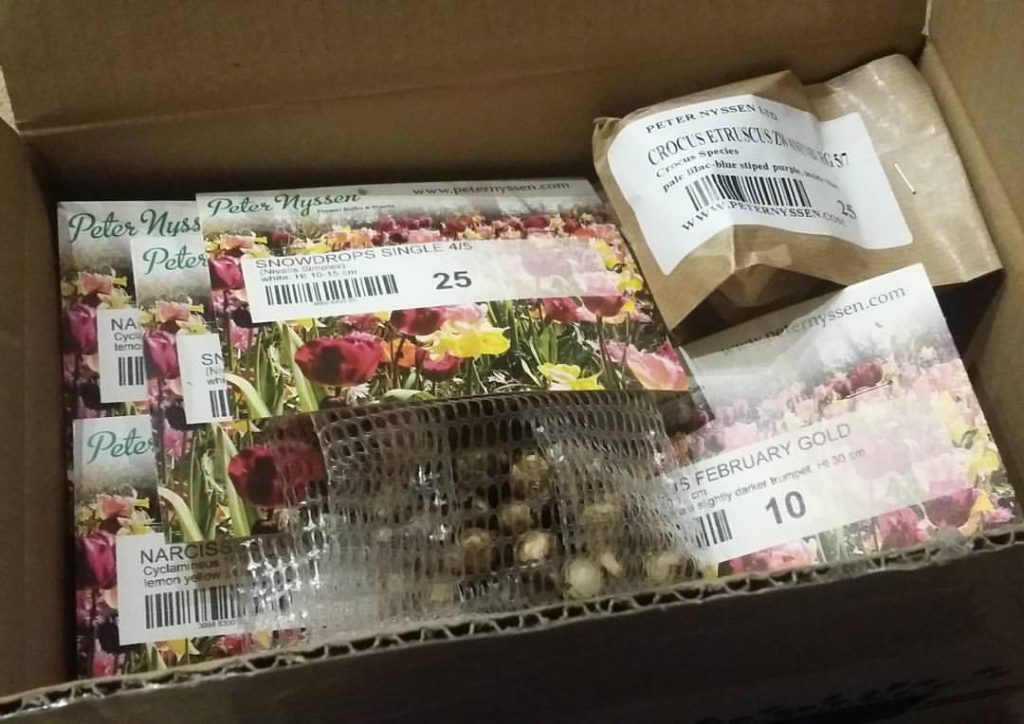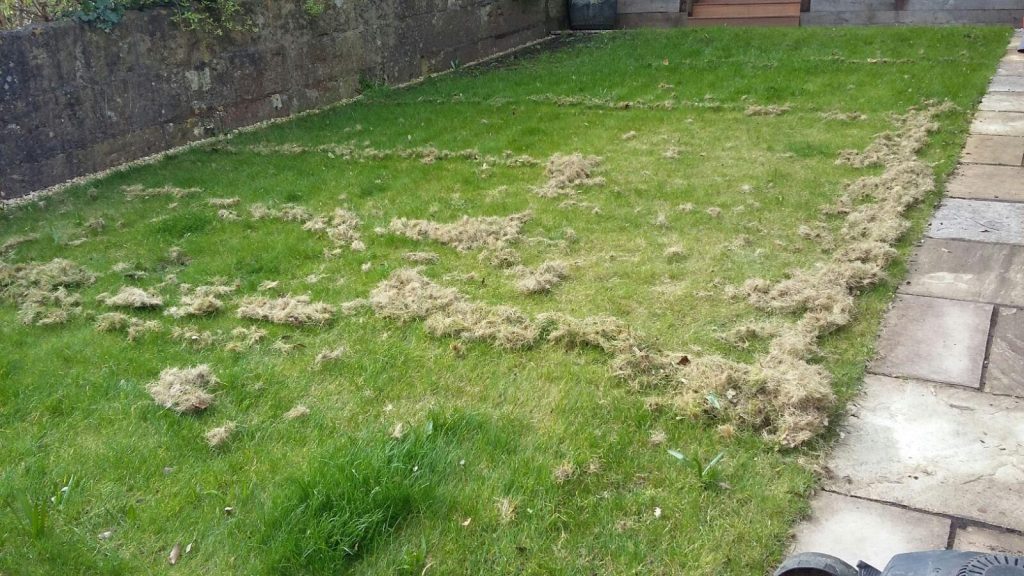The swallows have gone and summer temperatures of 30 (or even 40!) degrees seem like a distant memory. However, this does not mean a gardening hiatus until May. With a little ongoing maintenance over the autumn and winter months you can have a garden to enjoy come spring, rather than spend your spring catching up. Get ahead of the game with your October garden to do list:
Box hedges
October is the last month of the year to be keeping an eye out for box tree moth caterpillars. Generally speaking, the damaging caterpillars are not around during the colder period from November to February.
If you identify box moth caterpillars are present the preferred option is to remove them by hand and dispose of them. For small topiaries etc this is practical. For large hedges treat with Bacillus thuringiensis (a natural soil-borne bacteria) to kill caterpillars. Apply the treatment in the early morning to prevent it from evaporating before it can take effect. Use only when box tree moth caterpillars are present to target this species only and ensure minimal destruction of other insects.
Use in conjunction with a pheramone trap to really interrupt the lifecycle of the box tree moth and maximise efficacy.
Plant Spring Bulbs

Spring bulbs have been available since September. If you have not already made your order, you should do so without further delay. Off the back of several consecutive dry summers, stocks may be limited. In previous years, unusually warm weather has had a detrimental effect on the bulb harvest. The 40 odd degree heatwaves and periods of drought experienced in Europe this year may not have helped this year’s crop either. I certainly found it very difficult last autumn to buy the bulbs I want for my clients often having to resort to alternatives, or going without entirely and I expect stocks could run out just as quickly this year too.
From the UK I can recommend Peter Nyssen bulbs, or for something a little closer to home, try Bulb ‘Argence who are France-based but also English speaking.
Once you receive your bulbs – except for Tulips – plant them immediately to let them establish before the coldest of the weather arrives. Leave planting Tulips until November to minimise the risk of any bulbs rotting in autumn rains or Tulip fire disease spoiling next year’s show.
Divide And Plant Herbaceous Perennials
Autumn is the optimal time of year for dividing, moving or planting herbaceous perennials. The soil is still warm, but the rains have returned to rehydrate the parched soil. Dividing, moving or planting now allows the new plants a full three seasons to establish and root well before the drought of next summer. Spring time planting can leave you having to irrigate an awful lot through the summer to support those plants and get them through their first summer.
Many herbaceous perennial plants may be propagated by division at this time of year. Grasses are an exception to this general rule, and division of grasses should wait for spring. The method is simple; make multiple clones of your favourite plants by chopping/breaking/splitting the plant apart into smaller plantlets and replanting them.
If you’re not sure whether your particular plant can be divided in this way, consult the Royal Horticultural Society website. It has a great plant finder database that will give you detailed information about your plant, including details of how it may be propagated.
You can find a tutorial on how to divide your perennials here.
Designing and creating new plantings/updating existing areas of planting are my speciality and what I love doing the most. If you would like help with designing and planting your garden, please get in touch here.
Sow Seeds

Some Hardy Annual, Biennial and Perennial seeds should be sown now, either in pots or, if you have recently cut down areas of meadow, sow direct onto bare soil. Some seeds require the cold of winter (known as ‘vernalisation’) to trigger germination. Good examples include Cow Parsley (Anthriscus sylvestris), Wild Carrot (Daucus carota), Astrantia or Milk Parsley (Selinum wallichianum).
Autumn Lawn Care
Lawns have received a fair amount of punishment this year from the extreme temperatures we experienced in July and August, but are now bouncing back. The lawn may be looking a bit straggly as it regrows and so could do with a mow, even at this time of year. Continue cutting the lawn as regularly as the rains allow to get it to thicken out as much as possible. Mow longer than you ordinarily would; I find my clients always cut their lawns far too short, which can allow weed into the gaps and makes the lawn less tolerant to periods of drought. I always cut my lawn on a longer setting.
Scarify the lawn to remove the summer’s dead foliage. Add the thatch and moss to the compost heap. Aerate the soil, especially well walked areas. This will help the lawn to recover and take rain water and nutrients deeper into the soil. I don’t fertilise, but if you feel the need use an organic autumn formula feed.



If you treasure your lawn keep it free of leaves. Leaves block light to the blades below and kill them off creating gaps perfect for weeds to find their way into the lawn. Don’t waste the leaves, they are an important ingredient for making healthy soil. Blow or rake them into flower beds where the worms will take them down into the soil. Alternatively, add them to the compost heap, or use them to make leafmould.
Herbaceous Perennials
Don’t cut them back!!!
Many blogs and websites will tell you you should be cutting back your perennials once they ‘go over’ this month. I would urge you to consider leaving your perennials standing and not touch them until the end of winter.
I am strongly of the opinion that it benefits the plants themselves since the dead foliage provides protection to delicate new growth beneath at the end of winter.
Leaving them for just one annual cut back at the end of winter reduces maintenance for you and also gives a winter home to wildlife. I have toads in my garden who right now are snuggled up beneath the shelter of my Nepeta. Yes, the Nepeta will start to look a bit ropey as we get to the end of winter, but because of the toads and hedgehogs I have the slugs and snails under control in my garden without the need for a chemical pesticide. It is not unusual to find in spring hedgehogs hibernating beneath the foliage of ornamental grasses.
Many perennials also look amazing lightly dusted in winter frost.

Don’t prune back herbaceous perennials, unless they should make an ungodly mess when they do eventually succumb to frost (Persicaria amplexicaulis can collapse into a bit of a mush, for example). Instead, just continue to deadhead as appropriate.
Hedges and Topiary

Bird nesting season has long since finished and, if you missed your chance to tidy your hedges or topiary in September, October is still a good month to get this task done. A crisp evergreen hedge or piece of topiary really helps to show off the garden in winter when all else is dormant.
Hardwood Cuttings
Why not make more of your favourite deciduous shrubs (such as Roses) and hedging for free? Take hardwood cuttings and either pot them up or plant them in a spare plot of ground. They do form roots slowly to start with, but they require no molly coddling and are the easiest form of cutting from which to reproduce woody plants. See this tutorial for a demonstration of how to take hardwood cuttings.
Winter protection for tender plants
If you grow your tree ferns and bananas in pots bring them under cover now before the frosts arrive.
Wrap tree ferns in horticultural fleece. Pack the crown (the growing point at the centre of this year’s fronds) with straw. Do this gently to avoid damaging any developing fronds.
If you have planted the Ethiopian Banana, Ensete ventricosum, outside it will certainly need lifting and bringing under cover. However, if you you have the more common Musa basjoo you can leave it planted the ground, provided you give it protection from the winter frost and wet, see here.
In the Potager
Tidy away tender annuals such as Tomatoes, Aubergines and Sweetcorn, which are by now finished. Any developing fruits are unlikely to ripen now. Make chutneys and preserves where you can, and remove the plants and add to the compost heap.
Prune this year’s finished canes (brown and woody) from summer raspberries and blackberries back to their base. Tie new canes (fresh, supple and green) to their supports ready to support next year’s fruit.

Empty the green house and clean it thoroughly with a diluted water/white vinegar mix.
Clean out and rinse any pots to minimise the risk of bacteria or pests overwintering in the greenhouse.
Continue harvesting late sown carrots or leafy crops such as salads, endives and red chicory. Leeks, Parsnips, maincrop potatoes and Brassicas are now starting to come into their own too, such as sprouts, cabbages and some types of cauliflower.
Harvest pumpkins and other squashes. Cut them from the plant leaving a short stump above the fruit. They will store well for several months in a dry and frost free place.
Check nettings and other protections; Autumn winds and rain may dislodge them and make your now maturing cabbages and other brassicas vulnerable to attack from pests.
Plant garlic bulbs now for larger/more cloves next summer. Simply plant like you would any other bulb at a depth of about twice the height of the bulb and water them in. Blackbirds do have a tendency to pull them from the ground as the foliage begins to poke through the soil, so either cover them or ensure a bird deterrent is to hand. Make sure to push back any bulbs the birds may uproot.

No responses yet